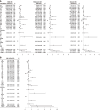Correlation between gynecomastia and endocrine regulation in patients with metabolic dysfunction-associated fatty liver disease: A cross-sectional study
- PMID: 40606934
- PMCID: PMC12210177
- DOI: 10.4254/wjh.v17.i6.108096
Correlation between gynecomastia and endocrine regulation in patients with metabolic dysfunction-associated fatty liver disease: A cross-sectional study
Abstract
Background: Metabolic dysfunction-associated fatty liver disease (MASLD) is a chronic liver disease characterized by hepatocellular steatosis, which is closely related to metabolic syndrome, with annually increasing morbidity in recent years. Gynecomastia (GYN), an abnormal proliferation of breast tissue in males, is common in males with sex hormone imbalance. Currently, there is insufficient research on the morbidity of GYN and its correlation among MASLD patients.
Aim: To investigate the prevalence of GYN and its associated clinical features in patients with MASLD and determine the prevalence of GYN in patients with MASLD and analyze the predictive effect of sex hormones on GYN using receiver operating characteristic (ROC) curves.
Methods: A cross-sectional study was conducted in a tertiary care hospital. Among them, 997 patients met the inclusion criteria and underwent breast ultrasonography to determine the presence of GYN. Anthropometric data, laboratory test data [estradiol (E2), androgens, liver function, glucose, lipids, low-density lipoprotein, high-density lipoprotein, creatinine, and uric acid, etc.], as well as information on medical history, severity of fatty liver (mild, moderate, and severe), and duration of the disease were collected. Package for the Social Sciences version 27 and R software (version 4.3.1) were used for data analysis.
Results: The prevalence of GYN increased with the severity of fatty liver (27.6% for mild, 33.5% for moderate, and 58% for severe, P < 0.001); compared with non-GYN patients, GYN patients were older (54.11 ± 9.71 years vs 47.89 ± 9.92 years, P < 0.001), with significantly higher E2 levels, higher estrogen to androgen ratio (P < 0.001) and significantly lower androgen levels (P < 0.001). In ROC curve analysis, the combined model of testosterone and E2 had a high diagnostic value in predicting GYN in MASLD patients, surpassing a single indicator.
Conclusion: The presence of GYN may suggest more severe metabolic abnormalities in patients with MASLD. Therefore, early recognition of GYN may be crucial for early intervention in metabolic syndrome and endocrine abnormalities in patients with MASLD.
Keywords: Gynecomastia; Metabolic dysfunction-associated fatty liver disease; Metabolic syndrome; Receiver operating characteristic curve; Sex hormones.
©The Author(s) 2025. Published by Baishideng Publishing Group Inc. All rights reserved.
Conflict of interest statement
Conflict-of-interest statement: All authors declare that there is no conflict of interest.
Figures



Similar articles
-
Signs and symptoms to determine if a patient presenting in primary care or hospital outpatient settings has COVID-19.Cochrane Database Syst Rev. 2022 May 20;5(5):CD013665. doi: 10.1002/14651858.CD013665.pub3. Cochrane Database Syst Rev. 2022. PMID: 35593186 Free PMC article.
-
Association of Neutrophil/High-Density Lipoprotein Cholesterol Ratio with Metabolic Dysfunction-Associated Steatotic Liver Disease in Type 2 Diabetes Mellitus Patients: A Cross-Sectional Study and Predictive Model Construction.Diabetes Metab Syndr Obes. 2025 Jul 29;18:2597-2609. doi: 10.2147/DMSO.S528506. eCollection 2025. Diabetes Metab Syndr Obes. 2025. PMID: 40755748 Free PMC article.
-
The Significance of the Presence of Gilbert's Syndrome in Patients With Metabolic Dysfunction-Associated Steatotic Liver Disease (MASLD): A Retrospective Cohort Study.Cureus. 2025 May 30;17(5):e85074. doi: 10.7759/cureus.85074. eCollection 2025 May. Cureus. 2025. PMID: 40585738 Free PMC article.
-
The serum uric acid to apolipoprotein A1 ratio is independently correlated with metabolic dysfunction-associated steatotic liver disease in type 2 diabetes mellitus: findings from a single national metabolic management center cohort.Front Endocrinol (Lausanne). 2025 Jun 4;16:1619003. doi: 10.3389/fendo.2025.1619003. eCollection 2025. Front Endocrinol (Lausanne). 2025. PMID: 40535329 Free PMC article.
-
Risk of thromboembolism in patients with COVID-19 who are using hormonal contraception.Cochrane Database Syst Rev. 2023 Jan 9;1(1):CD014908. doi: 10.1002/14651858.CD014908.pub2. Cochrane Database Syst Rev. 2023. Update in: Cochrane Database Syst Rev. 2023 May 15;5:CD014908. doi: 10.1002/14651858.CD014908.pub3. PMID: 36622724 Free PMC article. Updated.
References
-
- Mantovani A, Valenti L. A call to action for fatty liver disease. Liver Int. 2021;41:1182–1185. - PubMed
-
- Armstrong MJ, Adams LA, Canbay A, Syn WK. Extrahepatic complications of nonalcoholic fatty liver disease. Hepatology. 2014;59:1174–1197. - PubMed
-
- Younossi ZM, Henry L. Economic and Quality-of-Life Implications of Non-Alcoholic Fatty Liver Disease. Pharmacoeconomics. 2015;33:1245–1253. - PubMed
-
- Riazi K, Azhari H, Charette JH, Underwood FE, King JA, Afshar EE, Swain MG, Congly SE, Kaplan GG, Shaheen AA. The prevalence and incidence of NAFLD worldwide: a systematic review and meta-analysis. Lancet Gastroenterol Hepatol. 2022;7:851–861. - PubMed
LinkOut - more resources
Full Text Sources
Miscellaneous

